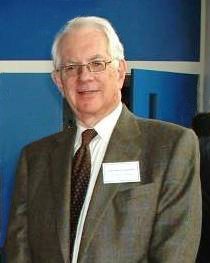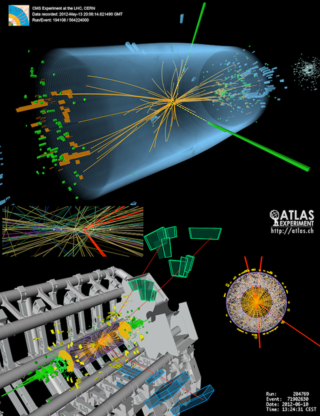Related Research Articles
In physics, the fundamental interactions or fundamental forces are the interactions that do not appear to be reducible to more basic interactions. There are four fundamental interactions known to exist:

In particle physics, an elementary particle or fundamental particle is a subatomic particle that is not composed of other particles. The Standard Model presently recognizes seventeen distinct particles—twelve fermions and five bosons. As a consequence of flavor and color combinations and antimatter, the fermions and bosons are known to have 48 and 13 variations, respectively. Among the 61 elementary particles embraced by the Standard Model number: electrons and other leptons, quarks, and the fundamental bosons. Subatomic particles such as protons or neutrons, which contain two or more elementary particles, are known as composite particles.

Particle physics or high-energy physics is the study of fundamental particles and forces that constitute matter and radiation. The field also studies combinations of elementary particles up to the scale of protons and neutrons, while the study of combination of protons and neutrons is called nuclear physics.

In nuclear physics and particle physics, the weak interaction, which is also often called the weak force or weak nuclear force, is one of the four known fundamental interactions, with the others being electromagnetism, the strong interaction, and gravitation. It is the mechanism of interaction between subatomic particles that is responsible for the radioactive decay of atoms: The weak interaction participates in nuclear fission and nuclear fusion. The theory describing its behaviour and effects is sometimes called quantum flavourdynamics (QFD); however, the term QFD is rarely used, because the weak force is better understood by electroweak theory (EWT).

The Standard Model of particle physics is the theory describing three of the four known fundamental forces in the universe and classifying all known elementary particles. It was developed in stages throughout the latter half of the 20th century, through the work of many scientists worldwide, with the current formulation being finalized in the mid-1970s upon experimental confirmation of the existence of quarks. Since then, proof of the top quark (1995), the tau neutrino (2000), and the Higgs boson (2012) have added further credence to the Standard Model. In addition, the Standard Model has predicted various properties of weak neutral currents and the W and Z bosons with great accuracy.

Steven Weinberg was an American theoretical physicist and Nobel laureate in physics for his contributions with Abdus Salam and Sheldon Glashow to the unification of the weak force and electromagnetic interaction between elementary particles.
In particle physics, the baryon number is a strictly conserved additive quantum number of a system. It is defined as

Sheldon Lee Glashow is a Nobel Prize-winning American theoretical physicist. He is the Metcalf Professor of Mathematics and Physics at Boston University and Eugene Higgins Professor of Physics, emeritus, at Harvard University, and is a member of the board of sponsors for the Bulletin of the Atomic Scientists.
In particle physics, the W and Z bosons are vector bosons that are together known as the weak bosons or more generally as the intermediate vector bosons. These elementary particles mediate the weak interaction; the respective symbols are
W+
,
W−
, and
Z0
. The
W±
bosons have either a positive or negative electric charge of 1 elementary charge and are each other's antiparticles. The
Z0
boson is electrically neutral and is its own antiparticle. The three particles each have a spin of 1. The
W±
bosons have a magnetic moment, but the
Z0
has none. All three of these particles are very short-lived, with a half-life of about 3×10−25 s. Their experimental discovery was pivotal in establishing what is now called the Standard Model of particle physics.

In particle physics, a gauge boson is a bosonic elementary particle that acts as the force carrier for elementary fermions. Elementary particles whose interactions are described by a gauge theory interact with each other by the exchange of gauge bosons, usually as virtual particles.

The LHCb experiment is a particle physics detector experiment collecting data at the Large Hadron Collider at CERN. LHCb is a specialized b-physics experiment, designed primarily to measure the parameters of CP violation in the interactions of b-hadrons. Such studies can help to explain the matter-antimatter asymmetry of the Universe. The detector is also able to perform measurements of production cross sections, exotic hadron spectroscopy, charm physics and electroweak physics in the forward region. The LHCb collaboration, who built, operate and analyse data from the experiment, is composed of approximately 1260 people from 74 scientific institutes, representing 16 countries. Chris Parkes succeeded on July 1, 2020 as spokesperson for the collaboration from Giovanni Passaleva. The experiment is located at point 8 on the LHC tunnel close to Ferney-Voltaire, France just over the border from Geneva. The (small) MoEDAL experiment shares the same cavern.
In particle physics, flavour or flavor refers to the species of an elementary particle. The Standard Model counts six flavours of quarks and six flavours of leptons. They are conventionally parameterized with flavour quantum numbers that are assigned to all subatomic particles. They can also be described by some of the family symmetries proposed for the quark-lepton generations.
In particle physics, a generation or family is a division of the elementary particles. Between generations, particles differ by their flavour quantum number and mass, but their electric and strong interactions are identical.
The J. J. Sakurai Prize for Theoretical Particle Physics, is presented by the American Physical Society at its annual April Meeting, and honors outstanding achievement in particle physics theory. The prize consists of a monetary award (US$10,000), a certificate citing the contributions recognized by the award, and a travel allowance for the recipient to attend the presentation. The award is endowed by the family and friends of particle physicist J. J. Sakurai. The prize has been awarded annually since 1985.

Luciano Maiani is a Sammarinese physicist best known for his prediction of the charm quark with Sheldon Glashow and John Iliopoulos.

Alexey Andreevich Anselm was a Russian theoretical physicist, Doctor of Physical and Mathematical Sciences, professor, director (1992–1994) of the B.P. Konstantinov Petersburg Nuclear Physics Institute (PNPI), member of: the Russian and American Physical Society, the executive committee of the Nuclear Physics Branch of the Russian Academy of Sciences, the editorial board of the Russian journal “Yadernaya Fizika”.

The Higgs boson, sometimes called the Higgs particle, is an elementary particle in the Standard Model of particle physics produced by the quantum excitation of the Higgs field, one of the fields in particle physics theory. In the Standard Model, the Higgs particle is a massive scalar boson with zero spin, even (positive) parity, no electric charge, and no colour charge that couples to mass. It is also very unstable, decaying into other particles almost immediately upon generation.
Anders Olof Gunnar Källén was a leading Swedish theoretical physicist and a professor at Lund University until his death at the age of 42.

Goran Senjanović is a theoretical physicist at the Abdus Salam International Centre for Theoretical Physics (ICTP). He received his Ph.D. at the City College of New York in 1978, under the supervision of Rabindra Mohapatra. Before joining the ICTP in 1991, he worked as a staff member at the Brookhaven National Laboratory and as a professor of physics at the University of Zagreb. His major research interests are neutrino physics, unification of elementary particle forces, baryon and lepton number violation and supersymmetry.

Riccardo Barbieri is an Italian theoretical physicist and a professor at the Scuola Normale Superiore di Pisa. He has written more than two hundred research papers in the field of theoretical elementary particle physics, and has been particularly influential in physics beyond the Standard Model.
References
- ↑ "Personal page at the Perimeter Institute for Theoretical Physics". Archived from the original on 2014-09-12. Retrieved 2014-08-28.
- 1 2 Personal page at Academia Europaea, Graz Information Centre
- ↑ Jarlskog, C. (1985). "Commutator of the Quark Mass Matrices in the Standard Electroweak Model and a Measure of MaximalCPNonconservation". Physical Review Letters. 55 (10): 1039–1042. Bibcode:1985PhRvL..55.1039J. doi:10.1103/PhysRevLett.55.1039. PMID 10031712.
- ↑ Georgi, Howard; Jarlskog, C. (1979). "A new lepton-quark mass relation in a unified theory". Physics Letters B. 86 (3–4): 297–300. Bibcode:1979PhLB...86..297G. doi:10.1016/0370-2693(79)90842-6.
- ↑ Doctor in Scientiis, Trinity College Dublin
- ↑ Rodriguez-Jauregui, E. (2001). "Implications of maximal Jarlskog invariant and maximal CP violation". arXiv: hep-ph/0104092 .
- ↑ Han, Tao (2010). The dawn of the LHC era: TASI 2008: proceedings of the 2008 Theoretical Advanced Study Institute in Elementary Particle Physics, Boulder, Colorado, USA, 2-27 June 2008. Singapore: World Scientific. p. 96. ISBN 9789812838353.
- ↑ Beyer, Michael, ed. (2006). CP Violation in Particle, Nuclear and Astrophysics. Berlin, Heidelberg: Springer-Verlag Berlin Heidelberg. p. 49. ISBN 9783540478959.
- ↑ Branco, Gustavo Castelo; Lavoura, Luis; Silva, Joao Paulo (1999). CP Violation. Oxford, U.K.: Oxford University Press. ISBN 9780198503996.
- ↑ "Speaker page of the 2011 Conference, Jyväskylä, Finland". Archived from the original on 2014-10-31. Retrieved 2014-10-31.
- ↑ Jarlskog, Cecilia (27 October 2014). "Viewpoint: Theory at CERN turns 62". CERN Courier.
- ↑ "Cecilia Jarlskog | Vrije Universiteit Brussel". Archived from the original on 2014-11-10. Retrieved 2014-10-31.
- ↑ "Credits and References for the 1999 Physics Nobel Poster". The Nobel Prize. Retrieved 25 June 2020.
- ↑ "EPS announces 2023 awards". CERN Courier. 20 June 2023.
- ↑ Jarlskog, Cecilia (2014). Portrait of Gunnar Källén: a physics shooting star and poet of early quantum field theory. Cham: Imprint: Springer. ISBN 978-3319006260.